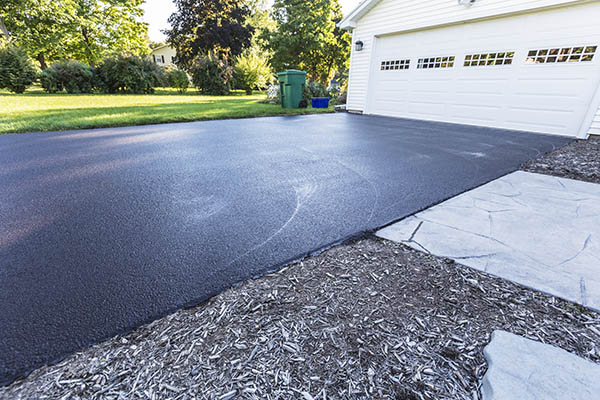Open the Tricks of Asphalt Sealing: Maximizing Hot Mix Asphalt Long Life
Wiki Article
Hot Mix Asphalt: A Sustainable Service for Sidewalk
Warm Mix Asphalt (HMA) has arised as a leading lasting option for pavement services, supplying a myriad of cutting-edge modern technologies and environmental advantages. As the demand for eco-friendly construction techniques expands, discovering the nuances of HMA's sustainability can give important understandings into the future of pavement solutions.Environmental Benefits of Hot Mix Asphalt

Moreover, Hot Mix Asphalt assists to alleviate city warm island effects. Its dark color soaks up sunlight, reducing the quantity of warmth reflected back right into the atmosphere contrasted to lighter-colored pavements. This can decrease ambient temperatures in urban areas, decreasing the demand for cooling and eventually reducing power intake.
Furthermore, Hot Mix Asphalt contributes to boosted stormwater administration. Its porous nature enables water to infiltrate the pavement and recharge groundwater supplies, minimizing overflow and the danger of flooding. These environmental advantages make Warm Mix Asphalt a sustainable option for leading roads and highways.
Power Performance in HMA Production
Is energy performance a vital consider the production of Warm Mix Asphalt (HMA)? Absolutely. Energy plays a significant role in the production of HMA, influencing both price and environmental sustainability. One essential aspect of power efficiency in HMA manufacturing is the use of warm mix asphalt (WMA) innovations (angled parking). WMA enables for the mixing and placement of asphalt at reduced temperature levels contrasted to traditional warm mix asphalt, leading to minimized power intake during manufacturing. This procedure not only lowers fuel use but likewise decreases greenhouse gas exhausts, making it a more eco-friendly alternative.Moreover, developments in plant technologies have actually led to more energy-efficient HMA manufacturing processes. Modern plants are developed with features like recycled asphalt sidewalk (RAP) processing abilities, efficient heater systems, and improved insulation, all adding to energy cost savings. By optimizing power use in HMA manufacturing, the industry can minimize its carbon impact while preserving high-grade sidewalk materials. Energy effectiveness is, for that reason, a vital factor to consider in making sure the sustainability of Warm Mix Asphalt manufacturing.
Recyclability of Warm Mix Asphalt
The recyclability of Warm Mix Asphalt (HMA) is an essential aspect of its sustainability and long-lasting ecological influence. HMA is just one of one of the most recycled products in the USA, with over 100 million lots of reclaimed asphalt pavement (RAP) being reused every year in brand-new sidewalk building. Recycling HMA offers numerous environmental advantages, such as minimizing the need for virgin materials, decreasing power usage during manufacturing, and reducing the amount of waste sent to land fills.The procedure of reusing HMA involves crushing the existing sidewalk, crushing it into smaller pieces, and mixing it with new aggregate and asphalt binder to create a recycled mix. This recycled mix can usually perform as well as or even much better than standard HMA, while calling for less basic materials and generating reduced greenhouse gas exhausts. By including RAP right into new pavement tasks, road agencies can preserve natural deposits, lower prices, and lessen the ecological impact of roadway construction and upkeep tasks. On the whole, the recyclability of HMA plays a considerable duty in advertising lasting practices within the sidewalk market.

Long-Term Performance of HMA
Asphalt sidewalks show longevity and durability over an extended period, mirroring the lasting performance of Hot Mix Asphalt (HMA) Furthermore, developments in HMA modern technology, such as the use of polymer-modified binders and warm mix asphalt, have even more boosted hot mix asphalt the longevity and longevity of HMA pavements. By focusing on top quality building and construction and upkeep practices, HMA continues to confirm itself as a affordable and sustainable option for long-lasting pavement facilities.
HMA: Longevity and Sustainability
Showing both longevity and sustainability, Hot Mix Asphalt (HMA) has actually become a foundation in the building of durable sidewalk facilities - angled parking. HMA's durability stems from its capability to stand up to heavy lots, extreme weather, and high website traffic volumes, making it a trusted selection for roads, freeways, and airport paths. The make-up of HMA, which generally includes accumulations, binder, and filler, plays an essential duty in enhancing its long life and resistance to tear and wear
Additionally, HMA's sustainability depends on its recyclability and energy-efficient production process. The ability to reuse redeemed asphalt sidewalk (RAP) in brand-new HMA mixtures minimizes the demand for virgin materials and reduces the ecological influence of pavement construction and maintenance. Furthermore, the energy efficiency of generating HMA exists in its lower blending temperatures compared to various other sidewalk products, causing lowered energy usage and greenhouse gas discharges.
Final Thought
In verdict, hot mix asphalt (HMA) provides a lasting remedy for pavement with its eco friendly attributes. HMA's recyclability, energy efficiency in production, and long-term sturdiness make it a green selection for roadway construction.
HMA is one of the most recycled materials in the United States, with over 100 million lots of recovered asphalt sidewalk (RAP) being recycled each year in brand-new sidewalk construction.The procedure of reusing HMA includes milling the existing pavement, crushing it right into smaller items, and mixing it with new accumulation and asphalt binder to create a recycled mix.Asphalt sidewalks show toughness and resilience over an extensive duration, mirroring the long-term performance of Warm Mix Asphalt (HMA) In addition, developments in HMA innovation, such as the usage of polymer-modified binders and cozy mix asphalt, have actually further enhanced the sturdiness and durability of HMA pavements. The capacity to reuse redeemed asphalt pavement (RAP) in brand-new HMA mixes lowers the need for virgin products and decreases the environmental influence of sidewalk construction and maintenance.
Report this wiki page